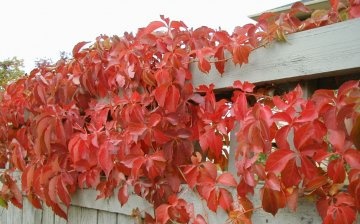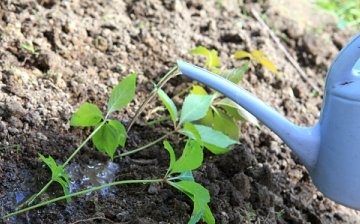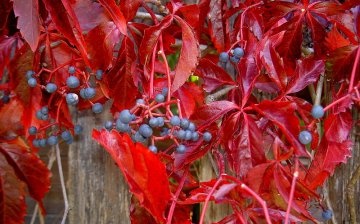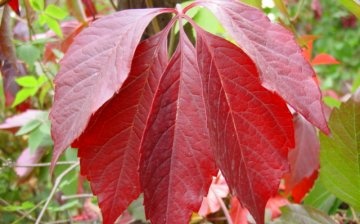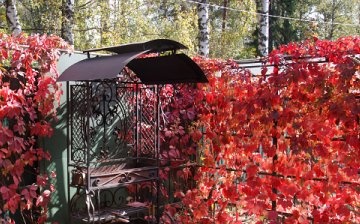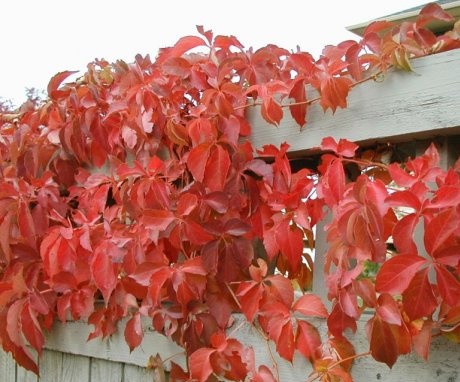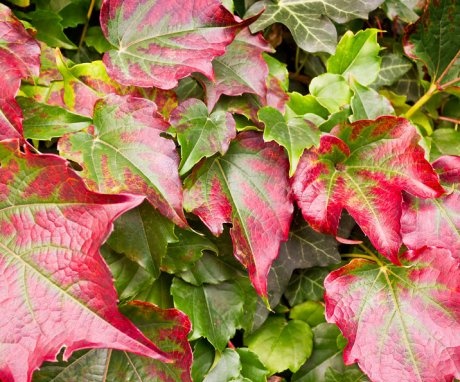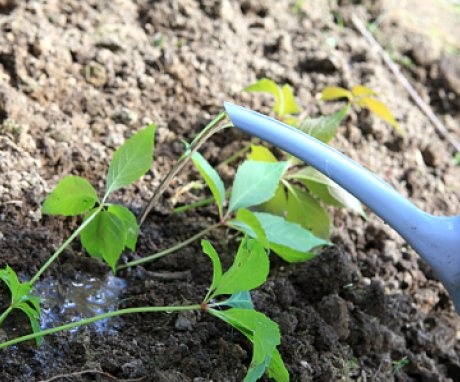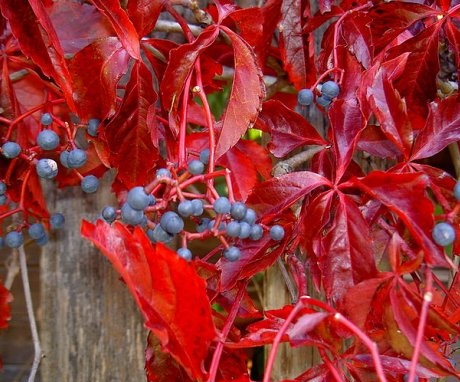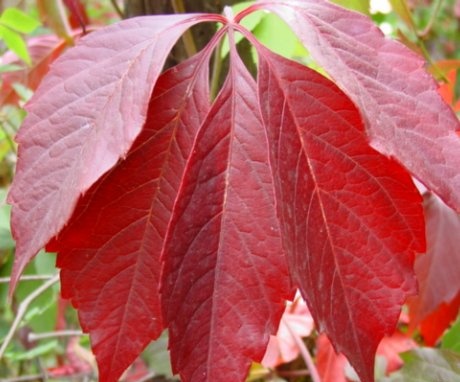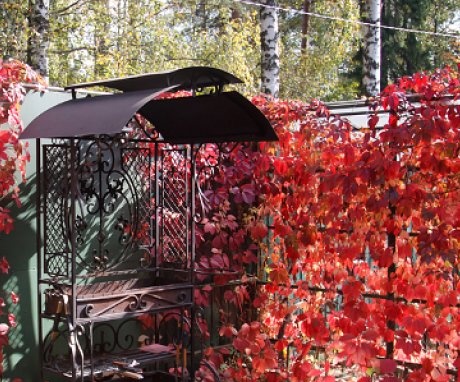Girlish grapes: planting and caring for a vine
Maiden grapes scientifically called Parthenocissus quinquefolia, which means virgin ivy. This is a representative of the grape family, which is actively used in landscape design. Liana-like vines are able to braid absolutely flat vertical surfaces and grow up to 15-20 meters in height. In this they are helped by peculiar roots-suckers, which are formed on the shoots in the process of development.
The plant began to grow back in the 17th century in European countries. Over the years, gardeners have become aware of about twelve varieties of plants that came from Asian and North American countries.
Content:
- Features of the appearance of girlish grapes
- Varieties of culture
- How the plant is propagated
- When and how to land
- Caring for a decorative vine
- What should the plant be protected from
- Application possibilities
Features of the appearance of girlish grapes
Liana earned its name due to the bunches of berries that form on the shoots. On the shoots, clusters of dark blue berries are formed, similar to grapes, but they are much smaller and cannot be eaten, therefore their function is exclusively decorative. A maiden plant is called because of its ability to self-pollinate.
The value of maiden grapes lies in the decorative foliage.
Depending on the lighting and the time of year, it is painted in burgundy reds and greens. And corn-growing vines are not capricious and easily tolerate frosts and shaded places. Therefore, this ivy can be planted anywhere. The growth rate of the plant is also striking, thanks to which the unsightly area can be hidden in a short time. But this riot must always be controlled so that the plant does not fill all the free space with dense vines and does not take on a sloppy look.
Gardeners prefer to plant maiden grapes on the site, not only because of decorativeness, but also for its ability to improve the microclimate and suppress the reproduction and spread of pathogenic microflora. A thick leafy carpet that envelops a house or a gazebo prevents dust and dirt from penetrating inside, and also prevents overheating on hot summer days.
Many gardeners and landscape designers opt for maiden grapes due to:
- decorativeness of variegated carved leaves, which bring a pleasant variety, changing color during the summer season
- unpretentiousness and drought resistance
- frost resistance
- immunity to diseases and pests
- rapid growth
- shade tolerance
And in the middle of summer, ordinary-looking faded flowers bloom in the green mass of foliage, which exude a pleasant aroma and attract pollinators. In their place at the beginning of autumn, dark waxy berries will appear, which will become an additional decorative element.
Varieties of culture
There are about twenty species in the genus of maiden grapes, but only two are preferred:
- Virginian (five-leafed) maiden grape.The species is distinguished by a finger-shaped leaf plate, which in shape resembles the structure of chestnut leaves. Each of the five leaf fragments has an oval-pointed shape with small scars along the edges. It can easily climb more than 15 meters of vertical surface. The plant is unpretentious and easily tolerates transplant to a new location. It grows equally well in sunny and shaded areas, but under the influence of sunlight it has a more decorative appearance. Virginia maiden grapes are rarely attacked by insect pests, but slugs, which love moist shady corners, can take a fancy to them.
- Ivy (tri-pointed) girlish grapes. The species has three palmate leaves, similar in structure to foliage ivy... At the tips of each vine, several tendrils with suction cups develop, with the help of which the plant clings to the support and grows up to 10-15 meters in length. Tri-pointed maiden grapes have several subspecies. The peculiarities of each of them is the color of the foliage in the autumn: in purple it acquires a burgundy color, in golden it - speckled yellow-green, and the popularity of the girlish grape "Vicha" is due to the small glossy foliage, which is painted in rich red-orange shades.
How the plant is propagated
For the propagation of maiden grapes, three methods are used: seed, layering and cuttings. Due to its unpretentiousness, girlish grapes do not require a special soil composition, but according to the observations of gardeners, it grows better in a prepared soil mixture of two parts of the earth, two parts of compost and one part of sand.
The seed propagation method is a long and laborious procedure that only experienced gardeners resort to. The success of the enterprise depends on the freshness of the seeds, because they quickly lose their germination and are suitable for planting within one year.
Breeding rules:
- Before sowing, the seed must be stratify, which can be carried out in a natural environment, by planting seeds for the winter.
- If planting is planned in spring, then the procedure is carried out 2-2.5 months before the event: moistened sand is poured into the container and seeds are placed in it, after which they are covered with polyethylene and sent to the cold. The temperature should not exceed five degrees Celsius.
- During the entire preparation time, it is necessary to periodically moisten the sowing until sprouts appear.
- Sprouted seeds are sown in open ground and after 30-40 days the plant will grow.
Reproduction by layering is used if maiden grapes are already growing on the site. For such reproduction, it is not necessary to separate the process from the plant. Enough:
- select two or three year old vines
- tilt them to the ground and fix
- sprinkle the attachment points with soil
- water regularly
By the next season, independent plants will form, which need to be dug up and transplanted to a permanent place.
Reproduction cuttings - the most common method among amateur gardeners. To implement it you need:
- Select ripe ligneous vines and cut them into fragments.
- Each stalk must have at least four buds.
- Cuttings are placed in the prepared hole, buds up, sprinkled with earth and watered.
- The planting should be protected from direct sunlight and moisturized regularly.
- Cuttings should be cut at the very beginning of spring, before the growing season begins.
When and how to land
Before planting maiden grapes, you should decide on the place where it will grow. On the sunny side of the site, the plant develops faster and in autumn it acquires a bright red hue, and in the shade it will grow a little slower and the foliage will remain green.
Maiden grapes can be planted both in autumn and spring. But experienced gardeners recommend carrying out this procedure in the first months of autumn.Landing is in the following sequence:
- A week before planting, the soil is dug up and weeds are removed.
- Dig a landing hole half a meter deep and equip it with drainage from small stones, expanded clay or broken brick.
- Drainage is sprinkled with a layer of sand and the hole is filled with prepared soil mixture.
- A seedling, cutting or sprouted seeds are placed in the hole and watered.
- At the initial stage of growth, the plant will need support, so you should take care of this in advance.
Caring for a decorative vine
Taking care of a girl's grapes is easy. The main thing is to water the plant in a timely manner and trim the lashes.
Due to the abundance of foliage, the soil under the vine rarely dries up, so the plant should be watered infrequently.
In a particularly hot summer, such events should be carried out no more than three or four times per season. And if it rains regularly in the place of growth, then the culture does not need watering. For active growth and increasing decorativeness from spring, girlish grapes should be fed with complex fertilizers, which are made once a week. The exception is the flowering period - no top dressing should be applied at this time.
Maiden grapes grow very quickly, so it is of great importance pruning plants, otherwise the green mass will become unmanageable and take on a sloppy look.
Gardeners give several recommendations for the formation of an ornamental shrub:
- As you grow, additional supports should be installed and shoots directed at them, and those that do not want to grow in the right direction should be removed.
- Weak, damaged and thickening shoots should be pruned regularly.
- Dried branches are cut in the spring.
- You also need to carry out sanitary pruning, which removes vines that are knocked out of the total mass.
The plant belongs to frost-resistant species, therefore it tolerates frost well and does not need shelter for the winter. If during the cold season some branches froze, then in the spring they are simply removed from, and the grapes are actively building up new deciduous mass.
What should the plant be protected from
The main enemy of girlish grapes is slugs and decay. root system with excessive watering. To prevent the latter, the plant should be watered only during the dry season.
And there are several proven methods for dealing with slugs6
- Lemon peel trap. Cut the fruit in half and remove the pulp. A hole is made in the peel and placed near the plant. Slugs are taken inside and while they are feasting on citrus, they can be easily collected.
- Beer trap. A tin beer can with the rest of the drink is buried in the ground near the plants so that the hole remains just above the soil level. After a week, slugs will accumulate in the jar and they should be removed, and pour another portion of beer into the jar and repeat the procedure.
Other insects and fungal diseases are not terrible for the plant.
Application possibilities
Maiden grapes are actively used to create hedge, which will not only decorate the territory, but also protect from road dust and purify the air. Also, the plant can be used to shade the gazebo. Such a shelter will protect you from the scorching rays of the sun and create a cozy corner for relaxation.
If you plant plants along a residential building and correctly distribute the vines, then the house will not overheat in the summer, and in appearance will resemble a medieval castle.
Girly grapes are easy to grow.
The only thing that you should pay attention to is the formation of the bush. If pruning is carried out on time, then the plant will decorate any site and will bring a lot of benefits to the owners.
More information can be found in the video:




